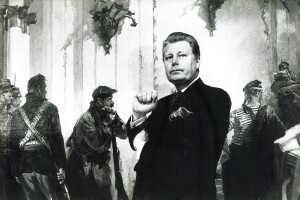
Discovered in a July 1991 copy of Boardroom Magazine, a glossy brochure covering ‘News, Views & a Taste of the Good Life ‘ is a large feature on the celebrity art dealer Roy Miles, then at the height of his fame ( or notoriety ).
Interleaved with the profile of Miles by one Alison Becket are a number of promotional items, including an invitation to attend Mr Miles’s ‘ Russian Summer Show ‘ at his gallery in Bruton Street, Mayfair, a mocked up page from the Mail on Sunday of October 1990 advertising a show by the Russian expressionist painter Sergei Chepik and other reproduced pages from the Daily Telegraph and the Sunday Times promoting Chepik and highlighting the fact that such famous people as Mrs Thatcher ( who was given a painting by Chepik) and Eddy Shah ( remember him?) had come to see works by the ‘ Russian genius’.
On the front cover of the magazine we are shown a photograph by Lord Snowdon no less of Mr Miles resplendent in dark suit, spotted tie and slicked back hair staring straight at the camera. Above this image we find the description that firmly nailed the dealer in the eyes of a certain type of wealthy art collector as ‘the Man Who Introduced Russian Paintings to the West ‘. By ‘ Russian Paintings ‘ of course, we are not talking about Malevich, Tatlin and the Suprematists. They would not have appealed at all to the former Prime Minister whose favourite poem was ‘Elegy in a Country Churchyard’, and probably not to Mr Miles’s other clientele. No, the Russian paintings that Miles brought over to the UK were firstly Soviet Social Realism and then as a total contrast, the subversive and sometimes nightmarish depictions of torture and oppression that Chepik began painting as an exile in Paris from 1988 as his protest towards the Soviet regime.
Born in 1935 to a prosperous , art-loving middle-class family in Liverpool, he appreciated art and indeed won a prize for a watercolour aged ten. At the same time he was making money by selling Dinky Toys to his fellow schoolboys. He had arrived in London by the late fifties and for a short time worked for an antique dealer. At one point he was set to do an art course at the Sorbonne, but a strong business sense turned him in another direction. He bought a group of salons in the swinging sixties, but sold up within two years and invested the money in his first Old Master paintings towards the close of the decade. He then became a specialist in sporting art and indeed paid a record sum for a Stubbs. By now he owned a penthouse in Cannes and a yacht, but the 1973 recession put paid to the market in sporting art and Miles looked for other opportunities. He found one in Victorian art, then highly unfashionable and therefore cheap.’ People said I was mad. Insufferable sentimental rubbish they called it. Or story-telling twaddle’. But the paintings sold —both to rock stars and national institutions, such as the National Portrait Gallery. He was also instrumental in raising the price of Pre-Raphaelite paintings.
Then illness struck when Miles was in his fifties. A heart condition jeopardised his future as a dealer, but he was still making lucrative deals. A lucky meeting with the collector George Costakis turned his attention towards Russian art and a subsequent tourist trip in 1985, where he found the hotels and food ‘ ghastly ‘, resulted in repeat visits and some purchases of Soviet Social Realism. His first major deal was Leonid and Tikhomirov’s ‘ Anastasia Stepanovna ‘, which was comparatively cheap compared with Repin’s The Artist’s Daughter, which set Miles back $1m. Other works he was able to buy much more reasonably, including a painting by Volter of Lenin’s funeral, which his widow handed over in exchange for a colour TV set. These paintings he inevitably sold on at a huge profit in London, sometimes at the famous parties he held in his gallery where celebrity guests might include people as diverse as Princess Margaret, The Pet Shop Boys, Rudolph Nureyev, Michael Caine ,Edward Heath, Raine Spencer, Ossie Clark and the Duchess of Devonshire. All who attended these parties agreed that in their lavishness and over the top ostentation, they were unique. For instance, Miles brought over a troop of Cossack dancers to perform at one Russian exhibition. When a Russian thriller by newspaper magnate Eddy Shah needed launching Miles duly obliged by hiring Russia’s answer to the Gypsy Kings, who provide a guitar serenade. On this particular occasion the food and entertainment came to a cool £250,000, but the sale of a Chepik to ‘Charles Cholmondeley, cousin and heir to the Marquess ‘was doubtless welcomed. As for Mr Shah, having been beaten to a Chepik he had set his heart on, he was comforted by Miles, who introduced him to the Russian portraitist Israel Zoher, who had recently painted Princess Diana. According to one source, Miles received around 500 letters a week from Russia and employed two agents there.
Miles had conventional tastes in art and supported the great art critic Brian Sewell in his 1994 attack on Conceptual Art, notably the work of Tracey Emin and Damien Hirst. Doubtless his autobiography reflects his views on these two individuals. Miles retired from dealing around 1998 and died in 2012 aged 77. Philip Mould, the dealer and TV pundit, perhaps came closest to summing up Roy Miles when in an obituary he called him ‘ a man ahead of his time (who) applied style and media savvy with intermittent but conspicuous success to the often stuffy business of selling revered art…’
- M. Healey
